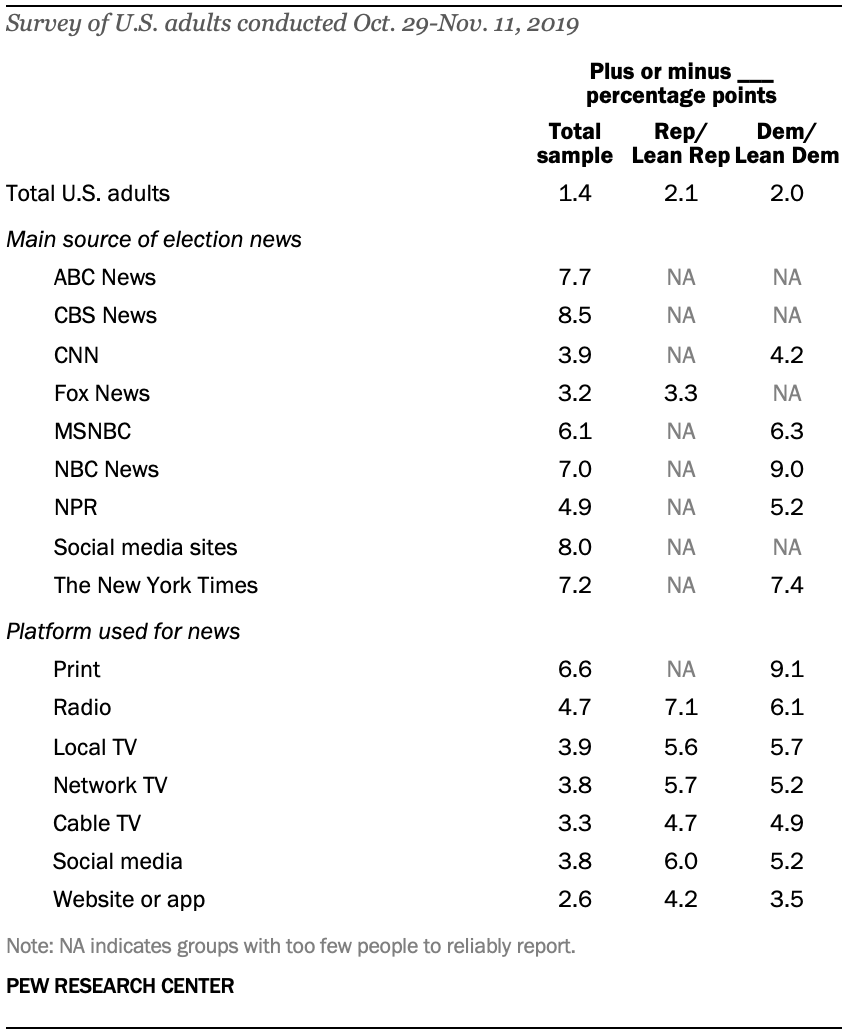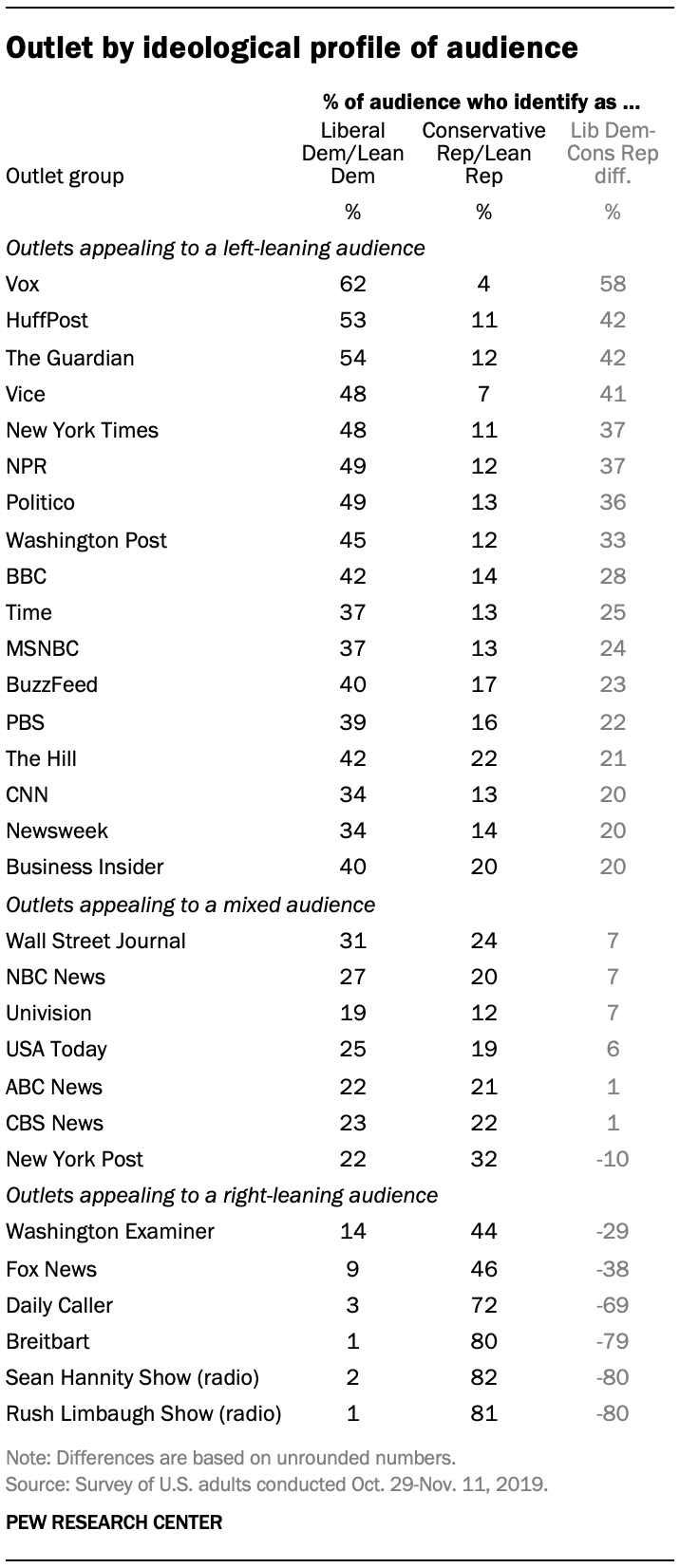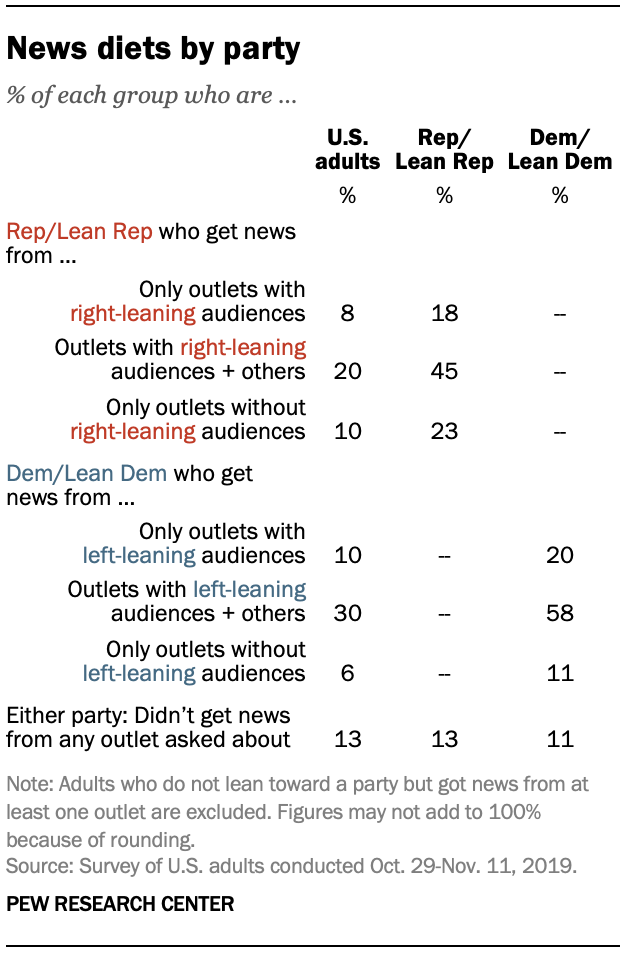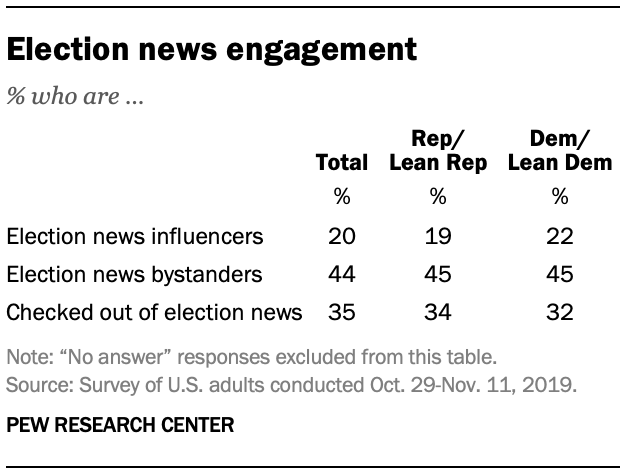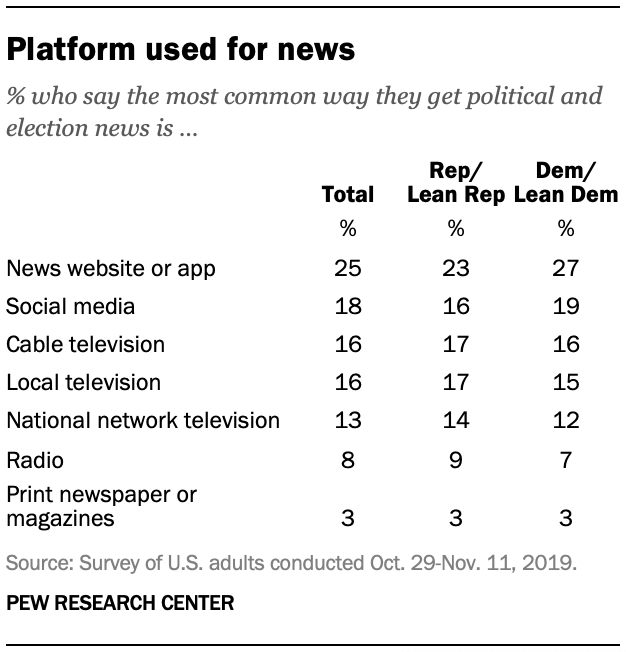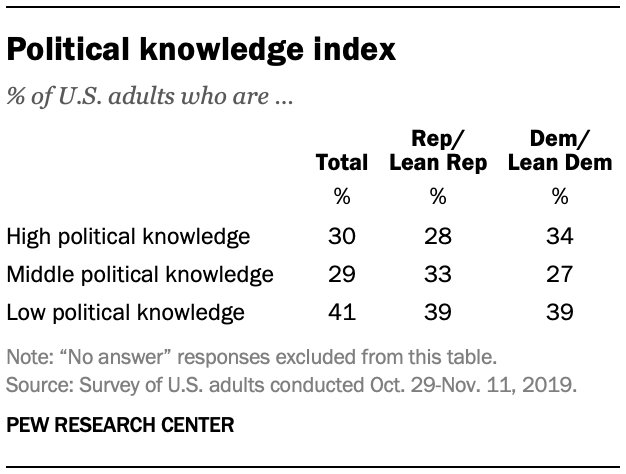General questions about the American News Pathways project
- What is American News Pathways?
- What data is available from American News Pathways?
- What did the project find?
- Does Pew Research Center have other data on the 2020 presidential election?
- What content can I expect from the Pathways project throughout the year?
Questions about getting help
- Why have I stopped receiving alerts about this project?
- Where can I request additional data and ask questions about the online data tool?
- The online tool or dataset is not working properly. Can you help?
- How do I read the results of the tables in the online data tool?
- How do I find data for questions asked on more than one survey?
Questions about methodology
- Where can I find the American News Pathways methodology?
- What are the margins of error for the variables in the data tool?
- How did you decide which news outlets to feature in your analyses?
- How did you determine the ideological composition of news outlets’ audiences?
- What do the news diets by party groupings mean?
- How did you measure election news engagement?
- How did you measure digital savviness?
- How did you measure main source of election news?
- How did you measure platform used for news?
- How did you measure trust in media by party?
- How did you measure overall political knowledge?
General questions about the American News Pathways project
What is American News Pathways?
American News Pathways is Pew Research Center’s year-long initiative exploring how Americans’ news habits and attitudes relate to what they heard, perceived and knew about the 2020 presidential election and COVID-19 and the protests against racism in the U.S. The initiative launched in January 2020 and ran through the election and its results, concluding in February 2021. The research is based on multiple waves of surveys conducted on the Center’s American Trends Panel, a nationally representative sample of U.S. adults, fielded between November 2019 and December 2020.
One main Pathways product is an online tool that makes our data available to the public for independent analysis. Beginning January 2020, the Center regularly updated the online tool throughout the year to provide users with the latest data. Click here for more details. The project has ended, but data in the tool range from November 2019-December 2020.
Additionally, there are more than 50 analyses which focus on key topics and findings from the data.
Learn more about the methodology here.
What data is available from American News Pathways?
The data collected for the American News Pathways project explores where Americans get their news, which news sources and platforms they trust to deliver information, and how this aligns with what they think and believe about the 2020 campaign, COVID-19 and the protests against racism in the U.S. Demographic factors – such as age, education and political affiliation – can be examined alongside people’s news media and election-related responses.
You can access the raw data behind this project in two ways: Use the online data tool, or create an account to download the survey datasets for independent analysis. Survey datasets are available in SPSS .sav file format. See here for details about survey dataset formatting. Note that some data variables are not included in public releases to protect the privacy of survey respondents. Release of open-ended questions may be delayed while they are coded.
What did the project find?
Read about key findings from five main areas of discovery from the project. You can also visit our landing page to access all of the project’s publications.
Does Pew Research Center have other data on the 2020 presidential election?
Yes. American News Pathways is just one component of Pew Research Center’s larger U.S. election research portfolio:
- To access all of Pew Research Center’s 2020 election-related publications, visit our Election 2020 hub.
- Read an explainer post by Pew Research Center President Michael Dimock describing how the Center is approached its election research in 2020.
What kind of content does the project focus on?
Analyses focused on how people’s media habits and attitudes relate to what they heard, perceived and knew about the election and COVID-19. Visit our project’s landing page to access our digital tool and datasets.
Questions about getting help
Why have I stopped receiving alerts about this project?
The American News Pathways project concluded in February 2021, following the aftermath of the 2020 U.S. presidential election. Please email info@pewresearch.org if you’d like to be added to our press lists for future Pew Research Center work focused on media or politics.
Where can I request an interview or briefing with a Pew Research Center expert about American News Pathways?
Pew Research Center places heavy emphasis on providing journalists with timely information on the issues, attitudes and trends shaping the world, and being available to discuss or explain the research.
Media or briefing inquiries about the project should be directed to Hannah Klein (202-419-4567, hklein@pewresearch.org), with your deadline specified.
You can also contact Rachel Weisel (rweisel@pewresearch.org) or the communications team (info@pewresearch.org, 202-419-4372).
I’m a reporter. How can my newsroom benefit from using American News Pathways data?
You and your colleagues will be able to access all data from this project via our online data tool. As you look back on the tumultuous year that was 2020, it is our hope that our findings will help provide valuable context. To learn more about accessing Pathways data through our online tool and datasets, click here.
Contact Hannah Klein (hklein@pewresearch.org) if you are interested in a briefing about the project for your newsroom. Note that we are currently working remotely due to the novel Coronavirus outbreak, but our experts are still able to offer virtual briefings. Please reach out for more information.
Where can I request additional data and ask questions about the online data tool?
For questions, please email info@pewresearch.org. We’ll do our best to accommodate your request in a timely manner. If you’re a reporter, be sure to specify your deadline.
The online tool or dataset is not working properly. Can you help?
Please note that pewresearch.org no longer supports Internet Explorer. Switching to another web browser to use the data tool is strongly recommended.
How do I read the results of the tables in the online data tool?
The tables in the data tool should be read horizontally, meaning the numbers add up to 100% across each row.
See the user guide for additional details on using the online data tool. If you need additional help, contact the team at info@pewresearch.org.
How do I find data for questions asked on more than one survey?
Some questions were asked more than once during the American News Pathways project between the fall 2019 and the end of 2020. The data tool will includes every time questions were asked in the American News Pathways data tool.
The most recent data initially appears when a question is selected. If a question has been asked multiple times, at the bottom of the screen there will be a sentence reading, “This question was asked on multiple surveys. Showing data from survey concluded on [DATE].” The survey end date and the triangle to its right are a drop-down box. By clicking on the date, end dates for previous surveys will appear and can be selected to analyze that data.
Questions about methodology
Where can I find the American News Pathways methodology?
Links to the methodologies for each survey in American News Pathways can be found in the list below. All survey data for American News Pathways comes from Pew Research Center’s American Trends Panel (ATP), which is the Center’s nationally representative panel of randomly selected U.S. adults. Interviews are conducted online for all participants. Participants who do not have internet access are provided with a tablet and internet service. For more details about the ATP, visit here.
As part of the American News Pathways project, the Center will interviewed the same approximately 9,000 U.S. adults over the course of the year to track news views and habits during the 2020 election.
The American News Pathway methodology is available here.
- November 2019 survey topline
- February 2020 survey topline
- March 10-16, 2020 survey topline
- Supplemental March 19-24, 2020 COVID-19 survey: methodology and topline
- April 2020 survey topline
- June 2020 survey topline
- September 2020 survey topline
- October 2020 survey topline
- November 12-17, 2020 survey toplines:
- November 18-29 survey topline
What are the margins of error for the variables in the data tool?
The following table shows the error attributable to sampling that would be expected at the 95% level of confidence for the media habit variables and demographic groups in the data tool:



How did you decide which news outlets to feature in your analyses?
The 30 sources included in this project were chosen so that respondents were asked about a range of news media across different platforms (e.g., television, print, radio, internet). Audience size, topic areas covered and relevance to the 2016 and 2020 presidential elections were also considered. More details on how these outlets were selected is available here.
How did you determine the ideological composition of news outlets’ audiences?
Each of the 30 news outlets included in the American News Pathways project is grouped according to the ideological composition of its audience. This grouping is based on the ratio of the proportion of the audience who self-identify as liberal Democrats (including independents who lean Democrat) to the proportion that identify as conservative Republicans (including independents who lean Republican).
The survey asked respondents to indicate whether they got “political and election news” from 30 national news outlet in the past week. An outlet is considered to have a left-leaning audience if the proportion of all audience members that identify as liberal Democrats is at least two-thirds higher than the proportion that identify as conservative Republicans. Alternatively, an outlet is considered to have a right-leaning audience if the proportion of all audience members that identify as conservative Republicans is at least two-thirds higher than the proportion that identify as liberal Democrats. And an outlet is classified as having a mixed audience if neither liberal Democrats nor conservative Republicans make up at least two-thirds more of the audience than the other.
Data for classifying the ideological composition of news outlets comes from the first survey of the American News Pathways project, conducted Oct. 29-Nov. 11, 2019, among 12,043 U.S. adults.
What do the news diets by party groupings mean?
The variable “News diets of each party” in the online tool groups respondents by party identification and the outlets they turned to for political and election news in the past week. Respondents were asked:
- Their party identification (or which party they lean to, if they do not identify with one); and
- Which of 30 outlets they got political and election news from in the past week.
News outlets’ audiences were defined as left-leaning, right-leaning or mixed based on the ideological composition of their audiences. See here for details on grouping outlets by the ideological composition of their audiences.
Each party is divided into three groups (for a total of six across both parties): those who consume only news sources whose audiences tend to align with the party and its ideology (e.g., Rep/Lean Rep who only get news from outlets with right-leaning audiences); those who consume news from outlets whose audiences tend to align with the party and its ideology plus outlets with politically different audiences (e.g., Rep/Lean Rep who get news from outlets with right-leaning plus left-leaning or mixed audiences); and those who do not get news from outlets whose audiences align with the party but do get news from outlets with politically mixed audiences, or whose audiences’ partisanship and ideology tends to align with the other party (e.g., Rep/Lean Rep who only get news from outlets with politically mixed or left-leaning audiences). Note that “Lean Rep” refers to independents who lean Republican, and similarly, “Lean Dem” refers to Democratic-leaning independents.
An additional group includes members of either party plus those who do not lean toward a party who got no political news from any of the 30 outlets asked about. (The 3% of all adults who do not lean toward a party but got political news from at least one of the 30 outlets is not a large enough sample to reliably include in the analysis.)
The detailed descriptions of each category:
- Rep: Only outlets with right-leaning audiences – Republicans and Republican leaners who get political and election news from only those outlets with right-leaning audiences.
- Rep: Outlets with right and other audiences – Republicans and Republican leaners who get political and election news from other outlets (with mixed or left-leaning audiences) in addition to those with right-leaning audiences.
- Rep: Only outlets without right audiences – Republicans and Republican leaners who get political and election news from none of those outlets with right-leaning audiences (but do get news from those outlets with mixed or left-leaning audiences).
- Dem: Only outlets with left-leaning audiences – Democrats and Democratic leaners who get political and election news from only those outlets with left-leaning audiences.
- Dem: Outlets with left and other audiences – Democrats and Democratic leaners who get political and election news from other outlets (with mixed or right-leaning audiences) in addition to those with left-leaning audiences.
- Dem: Only outlets without left audiences – Democrats and Democratic leaners who get political and election news only from none of those outlets with left-leaning audiences (but do get news from those outlets with mixed or right-leaning audiences).
- Either party: None of these outlets – Respondents from either party (plus those who refused to lean toward a party) who do not get political or election news from any of the 30 sources asked about in the survey.
How did you measure election news engagement?
The variable “Election news engagement” in the online tool gauges respondents’ involvement with election news, based on two separate indicators:
- Following political and election news very or somewhat closely
- Saying you tend to “lead the conversation more than listen” when talking about political and election news.
Respondents who refused any of these questions are excluded.
The detailed descriptions of each category are as follows:
- Election news influencers – Both follow political and election news very or somewhat closely and tend to lead conversations about political and election news.
- Election news bystanders – Either follow political and election news very or somewhat closely or tend to lead conversations about political and election news.
- Checked out of election news – Follow political and election news not too or not at all closely and tends to listen to conversations or not have those conversations at all.
How did you measure digital savviness?
The variable “Digital savviness” in the online tool is a measure level of use and comfort with digital technologies. It is based on responses to two questions:
- Reporting using the internet at least multiple times a day
- Being very confident in one’s ability to use electronic devices.
Respondents who refused any of these questions are excluded.
The detailed descriptions of each category are as follows:
- The digitally savvy – Both use the internet multiple times a day and are very confident in their ability to use digital devices
- Digital dabblers – Either use the internet multiple times a day or are very confident in their ability to use digital devices (but not both)
- The digitally disengaged – Do not use the internet multiple times a day and are not very confident in their ability to use digital devices
How did you measure main source of election news?
The variable “Main source of election news” in the online tool is the news outlet that respondents identify as where they turn most often for political and election news.
Respondents were asked in an open-ended question to specify “the specific news organization or source” they use the most. Researchers grouped these responses together by brand; for example, “NY Times,” “NYT” and “nytimes.com” all counted as indicating The New York Times.
How did you measure platform used for news?
The variable “Platform used for news” in the online tool reports the most common news platform that respondents use to get political and election news. Respondents were given a predetermined set of news platforms: print, radio, local TV, network TV, cable TV, social media, and websites or apps.
How did you measure trust in media by party?
The variable “Trust in media by party” in the online tool combines political party affiliation with how much respondents trust the information they get from “national news organizations.” The variable has four categories:
- Republicans who trust the media – Republicans and Republican leaners who say they trust the information they get from the national news media “a lot” or “some.”
- Republicans who don’t trust the media – Republicans and Republican leaners who say they trust the information they get from the national news media “not too much” or “not at all.”
- Democrats who trust the media – Democrats and Democratic leaners who say they trust the information they get from the national news media “a lot” or “some.”
- Democrats who don’t trust the media – Democrats and Democratic leaners who say they trust the information they get from the national news media “not too much” or “not at all.”
How did you measure overall political knowledge?
The “overall political knowledge” index gauges respondents’ knowledge of politics and current events. It is based on nine questions (correct answers in parentheses):
- Which party has a majority in the U.S. Senate (Republican Party)
- Whether the U.S. federal budget deficit has gone up, down or stayed the same since Donald Trump took office (gone up)
- Whether the unemployment rate in the U.S. has gone up, down or stayed the same since Donald Trump took office (gone down)
- Whether tariffs in the U.S. have generally increased, decreased or stayed the same since Donald Trump took office (increased)
- What determines the number of votes a state has in the Electoral College (the number of seats the state has in the U.S. House and Senate)
- Which party is generally more supportive of reducing the size and power of the federal government (Republican Party)
- Which party is generally more supportive of increasing taxes on higher income people (Democratic Party)
- Which party is generally more supportive of restricting access to abortion (Republican Party)
- Which party is generally more supportive of creating a way for immigrants who are in the U.S. illegally to eventually become citizens (Democratic Party)
Respondents who refused to give an answer to any of these questions are excluded. “Not sure” responses are coded as incorrect. Correct answers are as of October 2019.
The detailed descriptions of each category are as follows:
- High political knowledge – Answered 8-9 out of 9 questions correctly
- Middle political knowledge – Answered 6-7 out of 9 questions correctly
- Low political knowledge – Answered 0-5 out of 9 questions correctly


